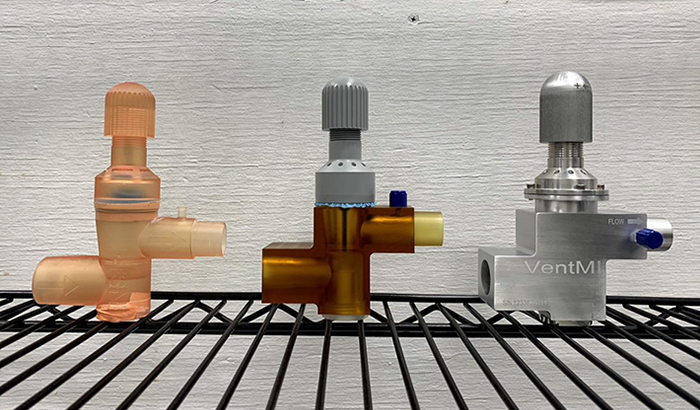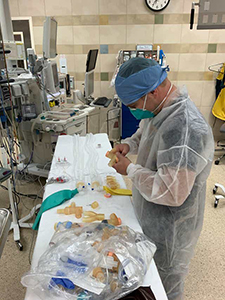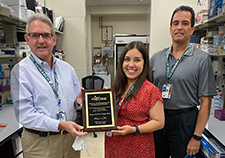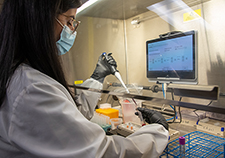Office of Research & Development |
 |


The image shows the VentMI device from its initial prototype (on left) to its final manufactured version. (Photo courtesy of Michigan Medicine)
June 2, 2020
Erica Sprey
VA Research Communications
"This invention is a cost-effective solution that improves on the current method of splitting ventilators between two patients, as a last resort, when the available supply of ventilators has been exhausted."
Ear, nose, and throat surgeon Dr. Kyle VanKoevering is doing his part to help Veterans and others who fall ill with COVID-19. Working together with a team at the University of Michigan, he developed a new device that will allow two patients with different needs to safely use the same ventilator.
As the scope of the COVID-19 pandemic became increasingly apparent, VanKoevering and his colleagues worried that not all hospitals would be able to provide ventilators for the sickest patients. They also knew that using a simple "vent-splitter," a Y-shaped adaptor that allows medical staff to deliver pressurized oxygen from one ventilator to two patients, had significant limitations.
"The problem is that for patients to share a ventilator using a currently available vent-splitter, they must have the same ventilator needs," said VanKoevering, according to the University of Michigan Health Lab. "Otherwise one person may receive excessive volume or pressure on their lungs, which can cause lung trauma."

Dr. Kyle VanKoevering is an ear, nose, and throat surgeon with VA and the University of Michigan. Well-versed in 3D printing for surgical applications, he and his collaborators designed a new device to enable safer sharing of ventilators between two patients. (Photo courtesy of Michigan Medicine)
His solution was to invent a device that would allow physicians to customize air pressure settings for patients using a single ventilator, based on the size and elasticity of their lungs and their ventilatory needs.
The device is similar to a regulator that is found on air tanks used for scuba diving. The invention, VentMI (Ventilate Multiple Individuals), consists of a two-chamber valve system that has a variable spring tension control which allows physicians to adjust pressures for each patient independently.
VanKoevering's invention also uses one-way valves to reduce the chance of cross contamination between patients. It attaches to most modern mechanical ventilators, is easy to set up, and requires minimal training for medical staff.
VanKoevering is a physician at the VA Ann Arbor Healthcare System and a clinical assistant professor at the University of Michigan. He is also an associate faculty member in the Department of Biomedical Engineering at the university. He is well-versed in using 3D printing for surgical applications, like printing a pre-surgical model of a patient's cleft palate.

VA center training the next generation of researchers in blood clots and inflammation

AI to Maximize Treatment for Veterans with Head and Neck Cancer

VA researcher works to improve antibiotic prescribing for Veterans

VA’s Million Veteran Program played crucial role in nation’s response to COVID-19 pandemic
VanKoevering first approached his colleague and business partner, pediatric otolaryngologist Dr. Glenn Green at the University of Michigan, with his idea. The two worked together to draw up specifications for their invention and create a prototype.
Prior to the pandemic, the two physicians had partnered with two other innovators: Dr. David Zopf, a head and neck surgeon at the University of Michigan, and Owen Tien, founder of Thingsmiths, a retail 3D printing company. Together, they set up a company, MakeMedical, LLC, to develop and market medical simulators produced through 3D printing.
The VentMI was a natural fit. Once the team had developed a prototype through 3D printing, they partnered with Grand Rapids-based Autocam Medical to create the final product, which is made of medical-grade aluminum.
"We have a team that prides itself on being able to move quickly on concepts and then manufacturing through our use of 3D printing, beating corporations with hundreds of millions of dollars," said Green, according to USA Today and the Detroit Free Press.
Bringing cutting-edge research and innovations quickly to clinical practice is a primary goal for the VA Office of Research and Development.
The VA Technology Transfer Program (TTP), part of ORD, helps commercialize VA inventions to benefit Veterans and other Americans. Often, inventors hold a dual appointment within VA and an academic affiliate, such as the University of Michigan. TTP works closely with affiliate partners across the country to bring promising VA inventions to market.
In the case of VentMI, TTP was collaborating with the Office of Technology Transfer at the University of Michigan to help VanKoevering's team pave the way for the rapid deployment of their product, which recently received an Emergency Use Authorization from the FDA. That status allows certain medical devices to be made broadly available during a public health emergency.
VentMI was first tested in simulated lung and animal environments. However, the inventors caution that the device should be used only in emergency situations where a standard ventilator is not available. (Click here to see a demonstration of VentMI.)
Because of the urgency of the COVID-19 pandemic, the founders of MakeMedical are providing VentMI at cost to interested medical institutions. VanKoevering and his team have created training materials for medical staff and plan to staff a 24/7 helpline.
"From an emergency-preparedness standpoint, VentMI is a good solution for medical centers that must quickly respond to critical patient needs during the COVID-19 pandemic," said TTP's Ryan Davis. "Emergencies like the COVID-19 pandemic can cause a sudden influx of patients requiring ventilation. This invention is a cost-effective solution that improves on the current method of splitting ventilators between two patients, as a last resort, when the available supply of ventilators has been exhausted."
Davis sees the product as a "great example of VA's ongoing coordination with top research universities and tech transfer programs across the country to help turn employees' innovations into real-world applications."
VA Research Currents archives || Sign up for VA Research updates